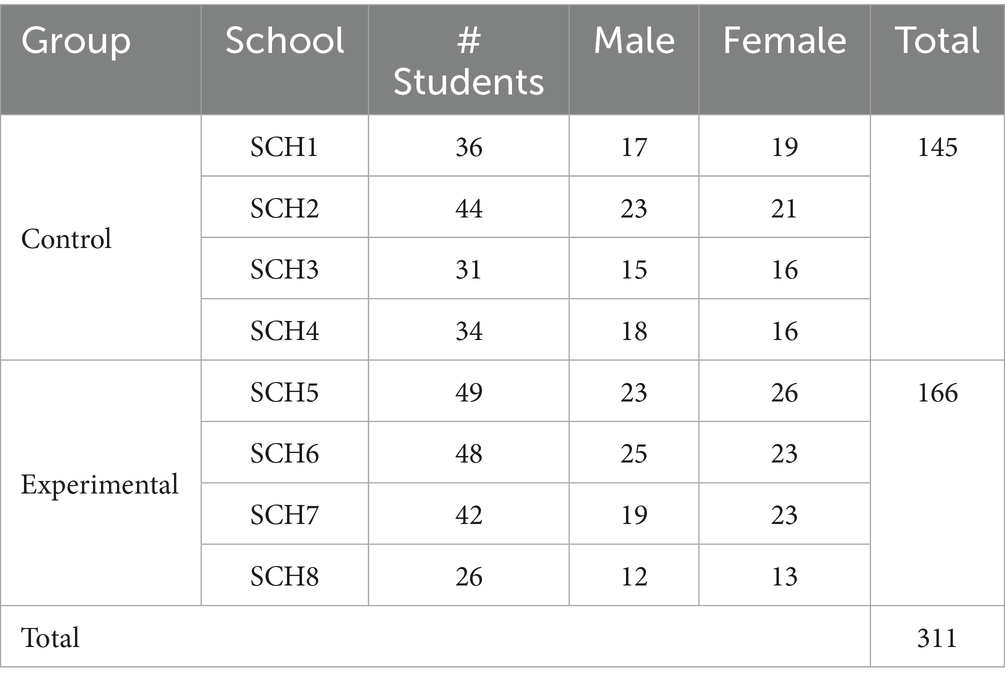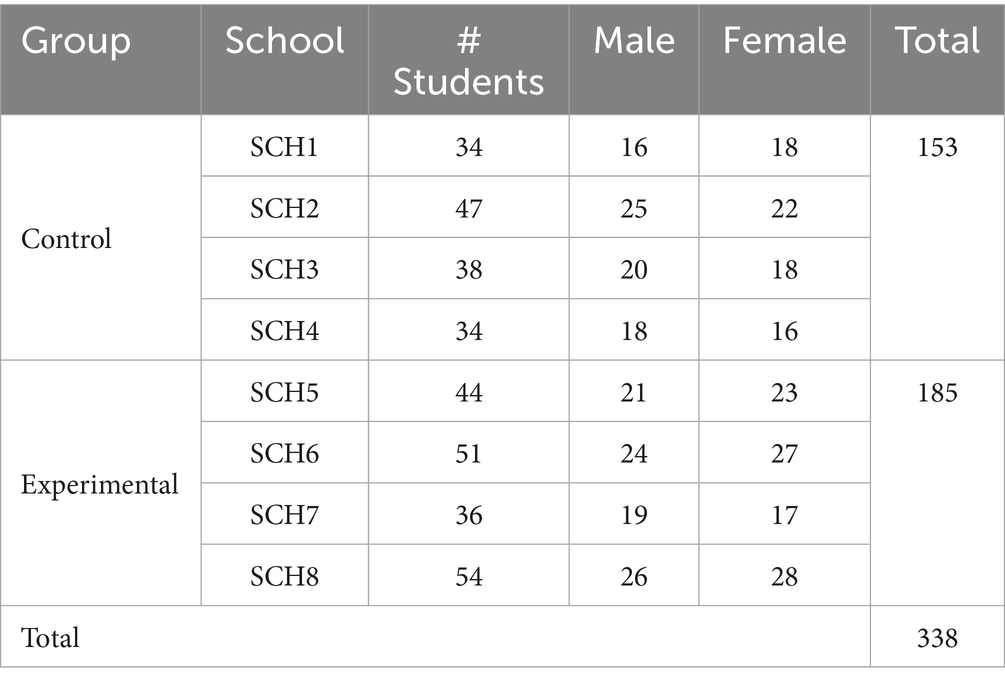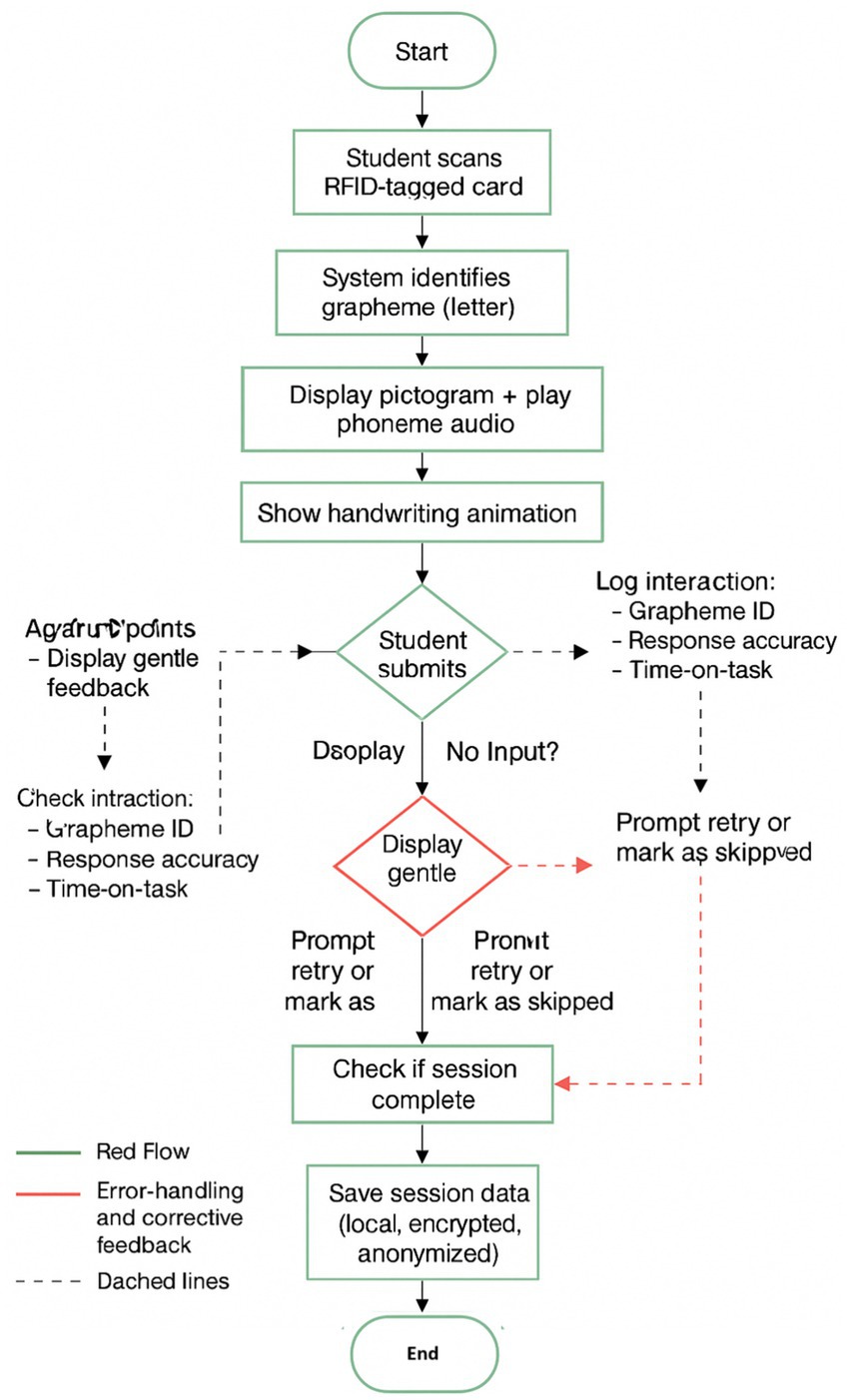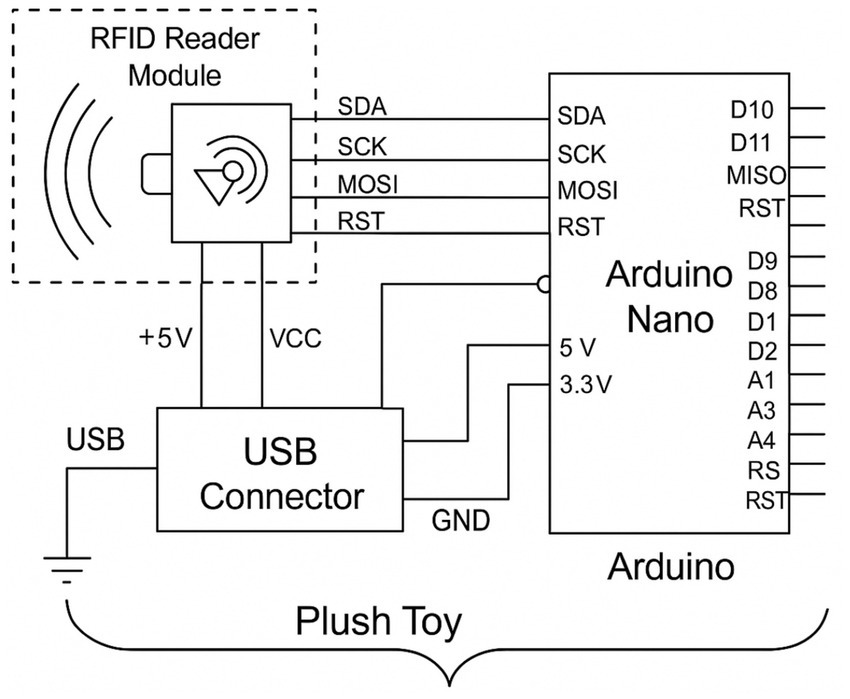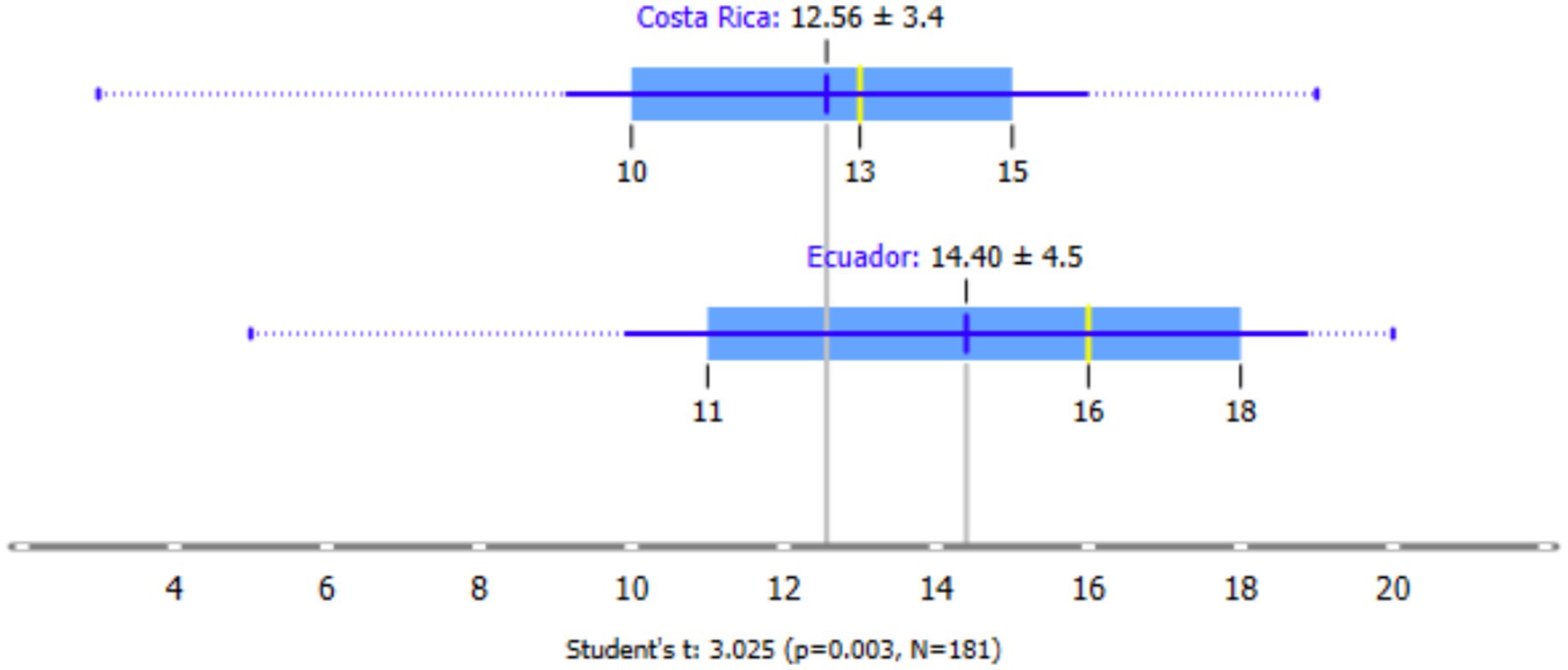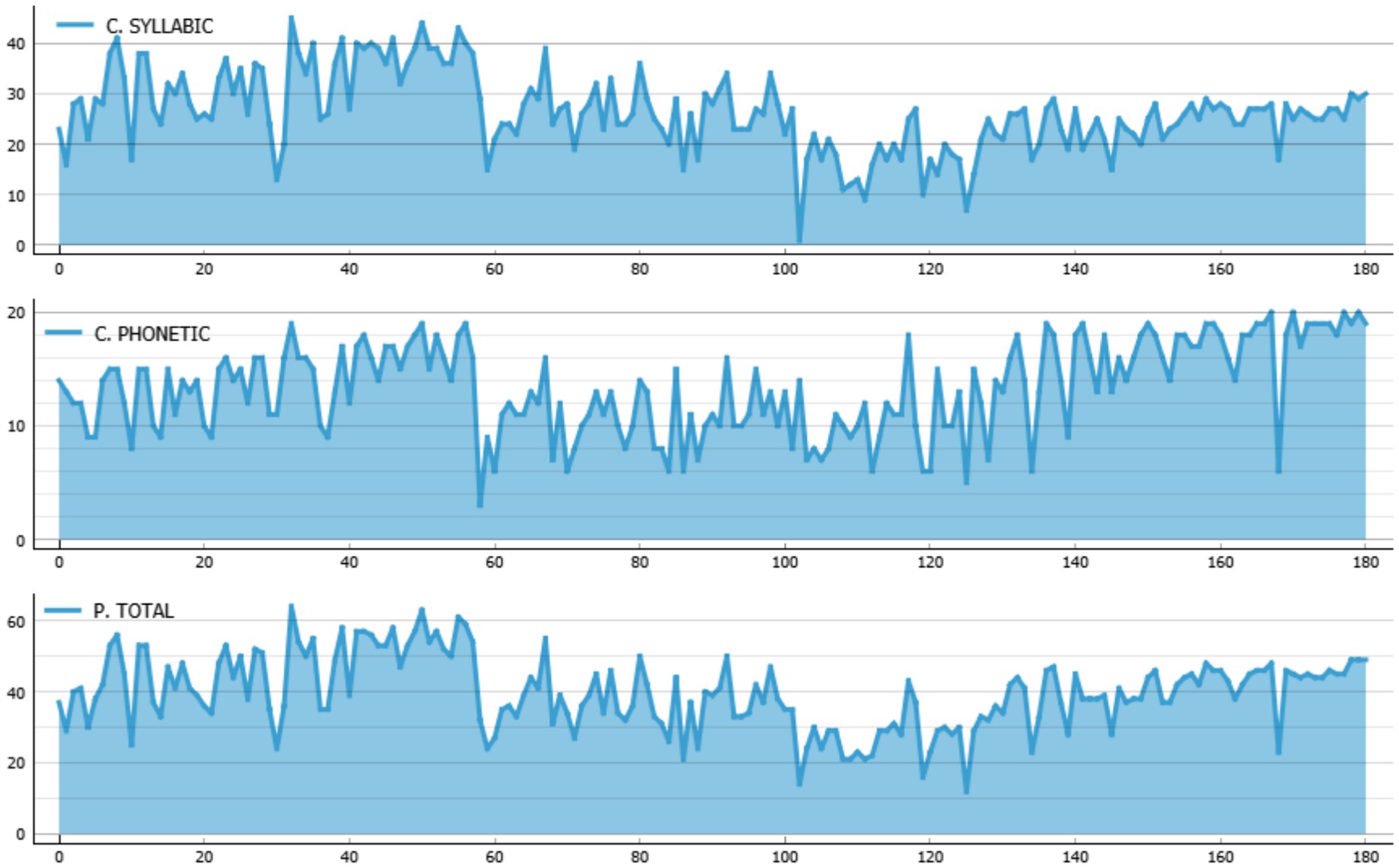- 1Quantitative Methods Department, Cunef Universidad, Madrid, Spain
- 2Centro de Innovación y Transferencia Tecnológica, Instituto Superior Tecnológico España, Ambato, Ecuador
- 3Intelligent and Interactive Systems Laboratory, Universidad de Las Américas, Quito, Ecuador
Reading proficiency is a cornerstone of children’s cognitive and emotional development, fostering both knowledge acquisition and intrinsic enjoyment. To transform early literacy into an engaging, playful experience, we introduce Game-Learning, a tangible educational prototype that merges pictophonic instruction, gamification, and operant reinforcement within an RFID-enabled toy. Game-Learning guides primary-age learners through multisensory grapheme–phoneme associations, pairing physical letter cards with interactive audiovisual feedback and reward mechanisms. We evaluated the platform in a 30-week quasi-experimental study involving 649 five-to seven-year-olds across 18 schools in Costa Rica (n = 311) and Ecuador (n = 338). Participants were randomly assigned to experimental (Game-Learning) or control (standard phonics instruction) groups. Pre-and post-tests assessed phonological awareness via a pictophonic reading protocol in Costa Rica and the Phonological Awareness Evaluation Test in Ecuador. During the intervention phase, experimental students used the Game-Learning system as part of their regular literacy lessons. Children in the experimental cohorts demonstrated significantly greater gains in both syllabic decoding (consonant–vowel combinations) and phonemic decoding (identification of single-letter sounds) compared to controls. By the post-test, over 85% of Game-Learning users reached age-appropriate mastery levels—more than double the improvement seen in the control groups—confirming the tool’s effectiveness as a reinforcement resource in both formal and informal learning environments.
1 Introduction
Young children acquire knowledge from their surroundings through social, emotional and physical stimuli. Introducing them to reading as an enjoyable pastime rather than a chore is crucial for fostering cognitive development and preparing them for adulthood (Rastle, 2019).
A recent report revealed that six out of 10 children and adolescents—some 617 million young people—fail to reach basic levels of reading proficiency (UNESCO Institute for Statistics, 2017). Among them, approximately 230 million 12-to 14-year-olds have significant comprehension difficulties. By the end of primary school, more than 56% of all children cannot read at the expected level; in secondary education, 61% still fall below minimum competency. These alarming figures underscore the urgent need for research into effective reading-promotion strategies.
In one study, preschool teachers were encouraged to cultivate early literacy skills—vocabulary development, initial writing conventions, and letter-sound awareness—in their students (Veríssimo et al., 2021). This foundational ability, known as phonological awareness, involves identifying and manipulating the sounds of speech. Phonics, in turn, addresses how those sounds are produced and perceived. Both skills are essential for mastering reading and writing in the early years.
Another investigation examined children’s capacity to perceive and manipulate the constituent sounds of spoken language (Melby-Lervåg and Lervåg, 2011). Such phonological sensitivity is critical for decoding and composing words and therefore underpins the acquisition of reading and writing.
Research conducted in Spanish-speaking contexts highlights the special importance of phonological awareness given the language’s complex sound structure (Míguez-Álvarez et al., 2022). Mastery of these sound-manipulation skills not only supports fluent reading and deep comprehension but also correlates with strength in spelling and grammar. Consequently, explicit instruction in phonological awareness should be a priority in Spanish-language early-education programs to ensure students develop the literacy foundations necessary for academic and lifelong success.
A study by O’Brien et al. (2019) evaluated Grapholearn, a tablet-based application that reinforces English word reading through explicit grapheme–phoneme mapping. Focusing on first-and second-grade students, the researchers found that children with low phonological awareness achieved significant fluency gains at the word level, while those with weaker statistical learning skills showed the greatest improvement at the phoneme level.
Ginat-Peleg and Barak’s digital spelling game (Elimelech and Aram, 2020) was designed according to dual-coding theory to support both auditory and visual processing. In their trial with 129 Hebrew-speaking preschoolers (mean age 5.7 years) from low–socioeconomic neighborhoods, four instructional conditions were compared: no support; whole-word auditory support; segmented auditory support; and combined auditory–visual support (highlighting individual letters as their sounds played). The auditory–visual group outperformed all others in letter knowledge, phonological awareness, word spelling, and decoding.
A comprehensive review by Jamshidifarsani et al. (2019) surveyed technology-based reading interventions in primary grades. The article synthesizes studies that integrate phonological awareness, phonics, fluency, comprehension, and vocabulary training through digital platforms, and identifies common instructional approaches and best practices.
Research on computer-assisted instruction (CAI) for non-English-language learners in U.S. schools (Cassady et al., 2018) tracked first-grade students’ progress on a standardized reading assessment over one academic year. Compared to a control group, the CAI participants demonstrated superior gains in vocabulary, phonics, phonological awareness, and text comprehension.
In India, Patel et al. (2022) implemented GraphoLearn English Rime for 5 weeks with 136 first-and second-grade students. Pre-and post-testing revealed that GraphoLearn users mastered letter–sound correspondences, rhyming units, and word recognition more rapidly and efficiently than peers in the control condition.
A year-long study of 122 sixth graders (Hurwitz et al., 2022) examined the Lexia PowerUp Literacy program, which targets word identification, grammar, and comprehension skills. Students using PowerUp achieved greater improvements in word-reading accuracy, syntactic processing, and basic comprehension than those receiving traditional instruction.
Finally, Lysenko and Abrami (2014) compared two web-based applications for English reading comprehension in 517 Canadian elementary students between 2010 and 2012. Multimedia-rich activities led to statistically significant gains in both reading and writing performance on standardized measures, relative to control groups.
This study introduces a novel pictophonic learning methodology—grounded in reinforcement learning and gamification—designed to strengthen early reading and writing skills in children from Ecuador and Costa Rica. We implemented this approach via a custom educational platform, Game-Learning, which combines RFID-enabled letter cards (one set of 30 Spanish-alphabet graphemes), an RFID reader, and a plush-toy “reading companion.” By embedding game mechanics and real-time feedback, Game-Learning encourages active manipulation of grapheme–phoneme associations and adapts dynamically to each child’s learning pace.
To assess its educational impact, we conducted a longitudinal field study with 5-to 7-year-old students across 20 schools (10 public, 10 private) in both countries. Over the course of a full term, participants engaged in regular Game-Learning sessions integrated into their literacy classes. Pre- and post-intervention assessments, together with classroom observations, demonstrated a marked improvement in students’ accuracy and fluency when mapping letters to sounds. These gains exceeded those typically reported for conventional phonics instruction, highlighting the tool’s efficacy in promoting durable grapheme–phoneme learning.
Section 2 details our materials and methods, including participant selection, development of the Game-Learning prototype, and data-collection procedures. Section 3 describes the hardware and software architecture of the system, as well as the specific gamified activities used to teach reading and writing. Section 4 presents experimental design and discusses pre-and post-test results in comparison with related interventions in literature. Finally, Section 5 summarizes our conclusions and offers recommendations for future research and broader application of this technology.
2 Materials and methods
This section outlines the pedagogical foundations and experimental procedures used in the development and evaluation of the Game-Learning prototype. We describe the pictophonic, gamification, and reinforcement-learning approaches that underpin our design, as well as the characteristics of the student population assessed via pre-and post-intervention testing.
2.1 Pictophonic method
The pictophonic method integrates traditional phonics instruction—focusing on the sounds of letters, vowels and objects (Maye et al., 2008)—with visual pictograms representing those sounds (Carpio Brenes, 2014). By linking each grapheme to a corresponding image and phoneme, this multisensory strategy accelerates letter–sound association and supports sequential skill acquisition (Feldman et al., 2013). Lessons are structured progressively, ensuring that students achieve optimal reading and writing outcomes within a condensed timeframe (Yoshida et al., 2010).
2.2 Gamification
Gamification applies game-design elements and dynamics—such as points, levels and feedback loops—to educational content (Oliveira et al., 2023), (Swacha, 2021). Its goal is to boost learner motivation, focus and engagement by framing tasks as interactive challenges (Lampropoulos et al., 2022). Empirical studies have demonstrated that gamified learning can substantially improve students’ productivity and goal attainment in literacy and other domains (Manzano-León et al., 2021).
2.3 Reinforcement learning
Rooted in Skinner’s operant-conditioning theory (Akpan, 2020), (Leeder, 2022), reinforcement learning (RL) in education employs rewards and consequences to shape desired behaviors. Initially, positive reinforcement—such as verbal praise or token rewards—is delivered immediately after a correct response to strengthen that behavior (Boakes, 2021). Negative reinforcement—removal of an unpleasant stimulus following an undesirable behavior—serves to discourage errors or off-task actions (Bosmans et al., 2020). Together, these techniques foster consistent, optimal learning behaviors by rewarding correct performance and reducing unwanted responses.
2.4 Study population
The sample study was drawn to ensure comparable socioeconomic backgrounds, geographic proximity of participants, and an equal balance between public and private schools. In each country (Ecuador and Costa Rica), 10 schools were initially targeted: five for the intervention group (using the Game-Learning application) and five as controls (no application). In Cartago, Costa Rica, administrative constraints limited participation to eight schools.
A total of 311 children aged 5–7 years were enrolled, with 166 assigned to the experimental (application) group and 145 to the control group. Table 1 lists the eight Costa Rican schools that participated, along with their respective student counts. All school authorities and parents provided informed consent prior to the study.
In Ecuador, we secured collaboration with 10 selected public and private educational institutions to participate in a longitudinal evaluation of the Game-Learning prototype. A total of 318 early-reader children were recruited at the outset. Following a baseline pretest, 185 students were allocated to the experimental group (Game-Learning intervention) and 153 to the control group (standard instruction). The intervention was implemented during regular literacy classes at each participating school.
Table 2 lists the Ecuadorian schools involved and the number of students enrolled at each site. Prior to data collection, formal approval was obtained from school administrators and written informed consent was secured from all parents or legal guardians.
The control groups received phonics instruction based on the official national literacy curriculum in each country. This included classroom activities such as letter recognition drills, guided oral reading, and teacher-led phonological awareness exercises. All sessions were delivered by the schools’ regular educators during standard instructional hours. To ensure methodological fidelity, members of the research team conducted regular site visits and classroom observations to verify that control group instruction was implemented consistently and without integration of any PicFon-Game-Learning components.
3 Game-Learning prototype design
The Game-Learning system integrates dedicated hardware and software components to deliver an interactive, multisensory literacy experience. The hardware core is an RFID-enabled plush toy that houses a reader module at its center. Thirty-one RFID-tagged cards—one for each of the 27 letters of the Spanish alphabet plus four control tokens—are used to represent graphemes. Each card contains a microchip encoding its letter identity and a small antenna that transmits this information when placed against the toy’s reader. The reader is connected via USB to a standard laptop, allowing real-time data exchange between the physical cards and the learning application.
On the software side, a custom program implements the three pedagogical pillars—pictophonic association, gamification, and reinforcement learning—outlined in Section 2. When a child scans a letter card, the system instantaneously displays the corresponding pictogram, plays the target phoneme, and issues points or visual rewards for correct responses. Mis-scans trigger gentle corrective feedback. All interactions, scores and progress metrics are logged for subsequent analysis. The complete system architecture and signal flow are depicted in Figure 1.
The Game-Learning prototype includes a desktop application developed in Visual Studio (C#.NET Framework 4.7.2). A clean, intuitive user interface enables entry of student details and tracks individual progress. When a learner scans an RFID-tagged letter card against the plush-toy reader, the application instantly identifies the selected grapheme and triggers an interactive video demonstrating the letter’s phoneme, its pictogram, and correct handwriting stroke order. Each letter presentation repeats twice, following the PicFon methodology to reinforce the grapheme–phoneme link.
Throughout each session, the software intersperses formative quizzes in the form of simple games: matching images with their initial letters, ordering graphemes to spell words, and selecting correct sounds. Correct answers earn points and encouraging messages (positive reinforcement), while incorrect responses prompt gentle corrective feedback. All interactions, scores and timestamps are logged for teacher review or autonomous self-learning. The system can be operated by an instructor in guided mode or by students independently, owing to its clear visual cues and automated feedback.
To clarify the internal functioning of the Game-Learning system, we developed a flowchart illustrating the software’s logic during instructional sessions (see Figure 2). The program currently follows a linear learning sequence structured around the PicFon methodology: upon scanning an RFID-tagged card, the system triggers phoneme playback, displays the corresponding pictogram, and launches a mini-quiz related to that grapheme. Feedback is immediate—correct answers are rewarded with points and visual cues, while incorrect inputs generate gentle corrective messages.
Although the current version applies a fixed instructional path for all learners, the software architecture has been designed with modularity in mind. This enables future implementation of adaptive learning paths based on individual student performance (e.g., error frequency, time-on-task, mastery tracking). Additionally, the system incorporates error logging for each student interaction, which facilitates detailed performance analysis and will inform subsequent algorithmic personalization strategies. In the current implementation, all data are stored locally in encrypted CSV files, anonymized by participant ID.
The system initiates a scan-read cycle, evaluates student input, delivers feedback, and logs performance data for future analysis and potential adaptivity development.
The PicFon-Game-Learning prototype was designed to promote fluency and deepen knowledge of phoneme–grapheme correspondences through “ubiquitous” (embedded and disguised) technology that encourages playful interaction with alphabet cards and everyday objects. Our evaluation framework draws on play-based learning theory, which posits that games foster children’s cognitive and sensorimotor development. We assessed three core dimensions:
1. Engagement: the child’s motivation to explore and interact with the tool.
2. Conceptual Mastery: the accuracy of grapheme–phoneme associations demonstrated during tasks.
3. Transfer: the application of learned correspondences to real-world reading and writing activities in the classroom.
First, grapheme–phoneme awareness is a foundational literacy skill: it enables young readers to map sounds to their written symbols, a prerequisite for decoding and spelling. Second, although Costa Rica and Ecuador share Spanish as their national language, cultural and dialectal variations can affect how children internalize phonological rules; our cross-country design allows us to identify and address these regional differences. Finally, both nations prioritize educational quality and learning outcomes; insights into effective grapheme–phoneme instruction can inform policy and practice, enhancing literacy instruction at scale.
3.1 Hardware specifications
To support replicability of the Game-Learning prototype, we provide detailed engineering specifications of the embedded RFID system used in the plush toy. A schematic diagram of the RFID reader circuit is included in Supplementary material (Figure 3), outlining all key electronic connections and signal paths between components.
The hardware system consists of the following components:
1. RFID Reader Module:
• Model: MFRC522 13.56 MHz RFID Module
• Communication Interface: SPI
• Operating Voltage: 3.3 V DC
• Operating Current: ~13–26 mA
• Reading Distance: Up to 5 cm
2. Microcontroller Unit (MCU):
• Model: Arduino Nano v3.0 (ATmega328P)
• Operating Voltage: 5 V
• Clock Speed: 16 MHz
• Interfaces Used: SPI (for RFID), USB (for PC communication)
3. RFID Cards and Tags:
• Type: MIFARE Classic 1 K cards
• Frequency: 13.56 MHz
• Material: PVC with embedded copper coil and EEPROM chip
• Quantity: 27 alphabet cards + 4 control tokens
4. Antenna and Signal Handling:
• The MFRC522 module includes an integrated planar antenna suitable for short-range NFC interactions within the plush toy. The antenna was tuned for optimal signal performance through placement testing and shielding adjustment.
5. Power Supply and Connectivity:
• Power Source: USB 2.0 (5 V DC) from laptop or tablet
• Power Regulation: Onboard AMS1117 voltage regulator (3.3 V for RFID module)
• Data Interface: USB Serial (UART) for data logging and application feedback
• Connection Cables: 4-pin Dupont connectors, USB–Micro B
This configuration ensures low energy consumption, safe interaction for young children, and seamless integration with the educational software. The reader and microcontroller are embedded in a compartment within the plush toy and are connected to a laptop via USB to enable bidirectional data flow with the Game-Learning desktop application.
3.2 Software architecture and instructional logic
To provide a more comprehensive view of the internal functioning of the Game-Learning system, we include an overview of its software architecture (Figure 4). The platform was developed using the C#.NET Framework (version 4.7.2) and interfaces with an RFID-enabled plush toy connected via USB to a host computer.
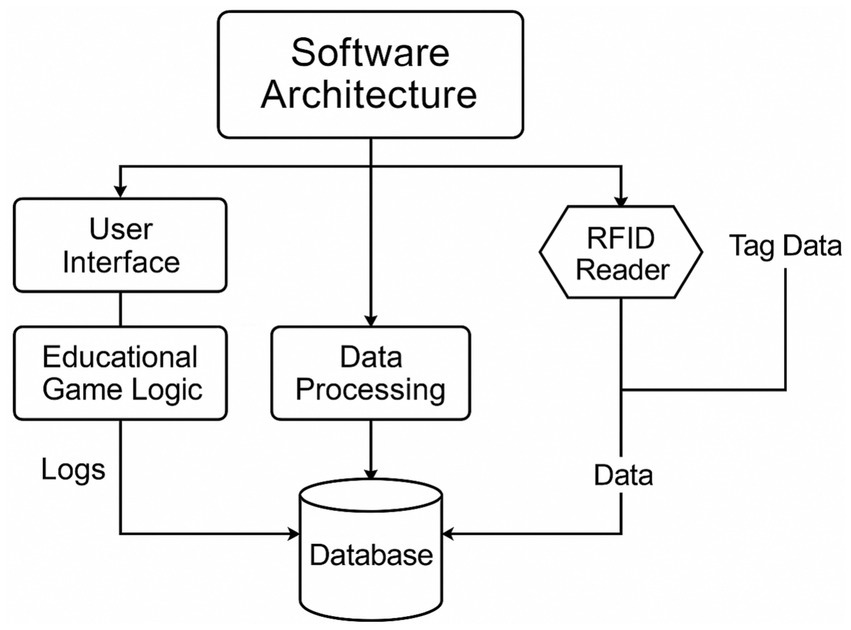
Figure 4. Software architecture of the Game-Learning system, illustrating the interaction between hardware, user interface, instructional logic, and data processing components.
The architecture consists of the following components:
• RFID Reader Module: Captures tag data from physical letter cards and sends it to the application.
• User Interface (UI): Displays phoneme videos, pictograms, and quizzes while receiving user input. It also provides immediate visual and auditory feedback.
• Educational Game Logic: Implements the fixed instructional sequence based on the PicFon methodology, manages feedback mechanisms, and drives reward dynamics such as points and animations.
• Data Processing Layer: Analyzes user input, tracks errors, and logs engagement metrics in real-time.
• Local Database: Stores anonymized learning records (e.g., score history, error frequency, session timestamps) in encrypted format for future review or adaptation.
During a typical session, the user scans a grapheme card, prompting the UI to display the associated phoneme and pictogram. A short quiz follows, and the system delivers immediate feedback. All interactions are logged for longitudinal performance analysis.
Although the current implementation follows a fixed learning sequence for all users, the system has been engineered with modularity to enable future personalization. The logged data can support adaptive learning paths by analyzing individual error patterns and mastery rates. Upcoming versions aim to leverage this architecture for dynamic task sequencing based on student performance metrics.
Robust error handling is embedded within the system to manage invalid scans, absent RFID signals, or disconnected hardware. In such cases, the user is prompted with corrective cues, and the session can resume seamlessly.
3.3 Teacher training and technical support
Prior to the intervention, schoolteachers responsible for implementing the PicFon-Game-Learning system in experimental groups received structured, in-person training delivered by the research team. This training covered the operation of the RFID-based hardware, navigation of the software interface, interpretation of recorded learning metrics, and pedagogical strategies for integrating the tool into existing literacy curricula. Additionally, illustrated user manuals were distributed, and continuous remote technical support was made available throughout the duration of the study.
In Costa Rican schools, where in-person visits were limited due to logistical constraints, training was delivered through live video conferencing sessions supported by interactive digital materials. This ensured that all participating educators were adequately equipped to operate the system autonomously and effectively support student learning.
4 Experiment and results
The primary objective of this study was to evaluate the Game-Learning prototype in both public and private schools across Ecuador and Costa Rica. We began by administering an individual letter-recognition pretest in a quiet room. Each child was presented with a randomized set of RFID-tagged cards bearing single letters and asked to produce the corresponding phoneme. Responses were recorded in a matrix alongside the student’s identifier, with correct phoneme matches indicated by colored cells and incorrect or omitted responses left blank.
All procedures were approved by the Human Subjects Ethics Committees at Instituto Tecnológico España of Ecuador. Written informed consent was obtained from parents or guardians, and participating schools provided institutional assent. The study adhered strictly to ethical guidelines, ensuring the physical and psychological wellbeing of every participant throughout the research.
Data collection unfolded in three phases. First, the baseline phonological awareness pretest identified children in both countries who struggled with grapheme–phoneme correspondence (control groups; see Tables 1, 2). Next, these students participated in a six-month intervention using the PicFon-Game-Learning tool, integrated into their regular literacy curricula. Finally, a posttest identical to the pretest was conducted to assess gains in letter-sound recognition among the experimental group (see Tables 1, 2, experimental cohorts).
Across both countries, we recorded 6 months of intervention data. Analysis was performed using Python libraries (Pandas, NumPy) and the Orange data-mining platform. In Costa Rica, 103 students completed both pre-and posttests; in Ecuador, 78 children participated fully (see Tables 3, 4). Each cohort was divided into two conditions: (1) standard preschool didactic strategies as outlined in national curricula, and (2) the same strategies augmented with the Game-Learning prototype. Student outcomes fell into three categories: “Normal” (typical learning trajectory), “Deficit” (persistent difficulty), and “Risk” (high likelihood of ongoing reading challenges).
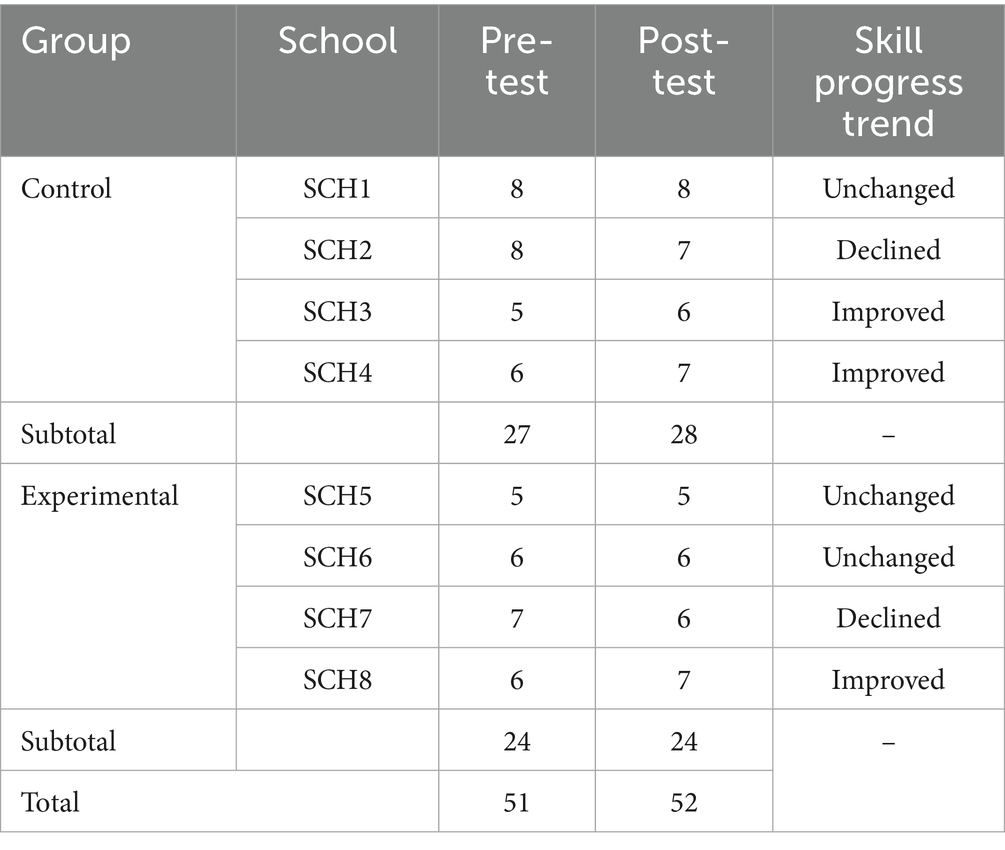
Table 3. Control and experimental groups in eight Costa Rican schools for pretest and posttest experiments.
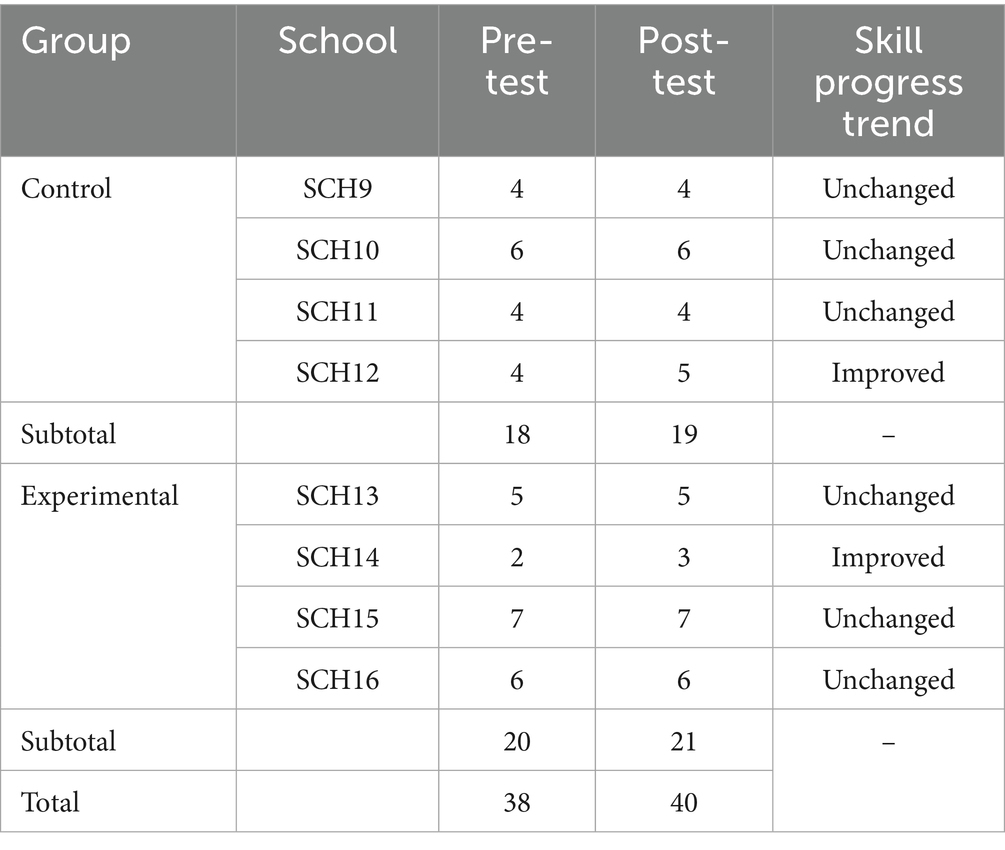
Table 4. Control and experimental groups in eight Ecuadorian schools for pretest and posttest experiments.
To enhance the interpretability and replicability of our classification, we established numerical thresholds based on the percentage of correct phoneme-grapheme associations recorded during post-tests. Specifically, students who achieved scores above 60% were categorized as “Normal,” those scoring between 40 and 60% were classified as “Risk,” and those scoring below 40% were labeled as “Deficit.” These cutoffs were determined by analyzing the distribution of post-test scores across both cohorts and aligning them with developmental literacy benchmarks suggested by national curriculum standards. This operationalization ensures transparency and facilitates future comparisons or replications in similar educational contexts.
Preliminary results indicate that children using Game-Learning exhibited marked improvements in grapheme–phoneme recognition, with a significant shift from the “Deficit” and “Risk” categories toward “Normal” performance levels, compared to the control group. These findings support the efficacy of a multisensory, gamified reinforcement-learning approach in accelerating foundational literacy skills.
Figure 5a presents boxplots of syllabic reading scores (each syllable composed of one consonant and one vowel) for students in Ecuador and Costa Rica following the six-month intervention. Costa Rican learners achieved a mean score of 29.52 (± 7.7), whereas Ecuadorian students averaged 22.18 (± 5.4). A two-sample Student’s t-test confirmed that this difference is highly significant (t = 7.535, p < 0.001, N = 181), indicating that while both cohorts benefited from the Game-Learning system, the Costa Rican group showed greater gains in syllabic proficiency.
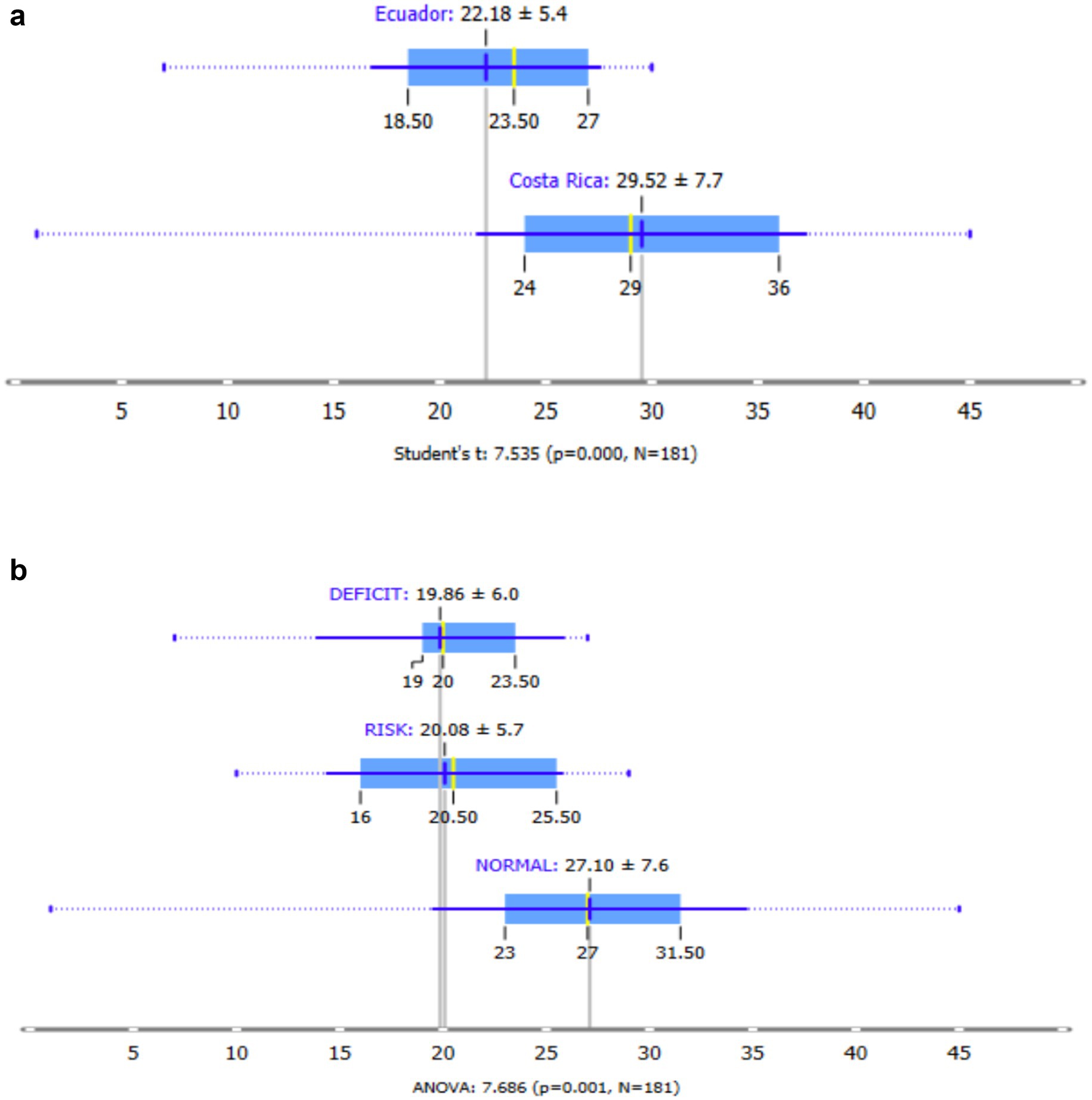
Figure 5. Comparison of syllabic reading scores between countries and learner types. (a) Syllabic reading scores by country after the six-month intervention (Costa Rica vs. Ecuador; mean ± SD; Student’s t = 7.535, p < 0.001, N = 181). (b) Syllabic reading scores by learner category (Deficit, Risk, Normal; one-way ANOVA F = 7.686, p = 0.001, N = 181).
Figure 5b stratifies the same syllabic scores by learner category—Deficit, Risk, and Normal—regardless of country. The Deficit group (19.86 ± 6.0) and Risk group (20.08 ± 5.7) both scored below the Normal group (27.10 ± 7.6). A one-way ANOVA revealed significant overall differences among these three categories (F = 7.686, p = 0.001, N = 181). Post hoc comparisons show that students classified as Normal outperformed those in the Deficit and Risk groups, confirming that baseline phonological awareness strongly predicts syllabic learning outcomes under the prototype.
Figure 5a displays significant differences in syllabic decoding between Costa Rican and Ecuadorian learners, with Costa Rica achieving higher average scores (p < 0.001). Figure 5b categorizes scores by learner types (Deficit, Risk, Normal), indicating that baseline phonological awareness correlates strongly with decoding performance after intervention.
Figure 6 compares phonetic reading scores—each student’s ability to correctly identify and articulate individual letter sounds—between the Costa Rica and Ecuador cohorts after the six-month intervention. Costa Rican children achieved a mean score of 12.56 (± 3.4), while Ecuadorian students averaged 14.40 (± 4.5). A two-sample Student’s t-test confirmed that this difference is statistically significant (t = 3.025, p = 0.003, N = 181), indicating that both groups improved their phonemic skills under the Game-Learning prototype, with Ecuadorian learners showing a somewhat larger gain.
These results demonstrate that the pictophonic, gamified methodology effectively strengthens single-letter sound mastery in diverse linguistic contexts. The higher mean score for Ecuador may reflect subtle differences in curriculum alignment, initial phonological awareness, or implementation fidelity across sites. Nonetheless, the strong significance level confirms that the prototype consistently supports phonetic decoding—a critical foundation for fluent reading—in both countries.
This figure illustrates post-intervention phonetic decoding results, showing that Ecuadorian students slightly outperformed their Costa Rican peers (p = 0.003). The results support the consistent effectiveness of the Game-Learning tool in improving single-letter sound recognition across diverse educational contexts.
Figure 7a illustrates the combined performance of Ecuadorian and Costa Rican students on the integrated syllabic-and-phonetic reading assessment following 6 months of PicFon-Game-Learning intervention. Costa Rica’s cohort achieved a mean score of 42.08 ± 10.4, while Ecuador’s cohort averaged 36.58 ± 9.1. A two-sample Student’s t-test revealed this difference to be highly significant (t = 3.774, p < 0.001, N = 181), indicating that both groups benefited from the prototype but that Costa Rican learners made even greater overall gains in decoding proficiency.
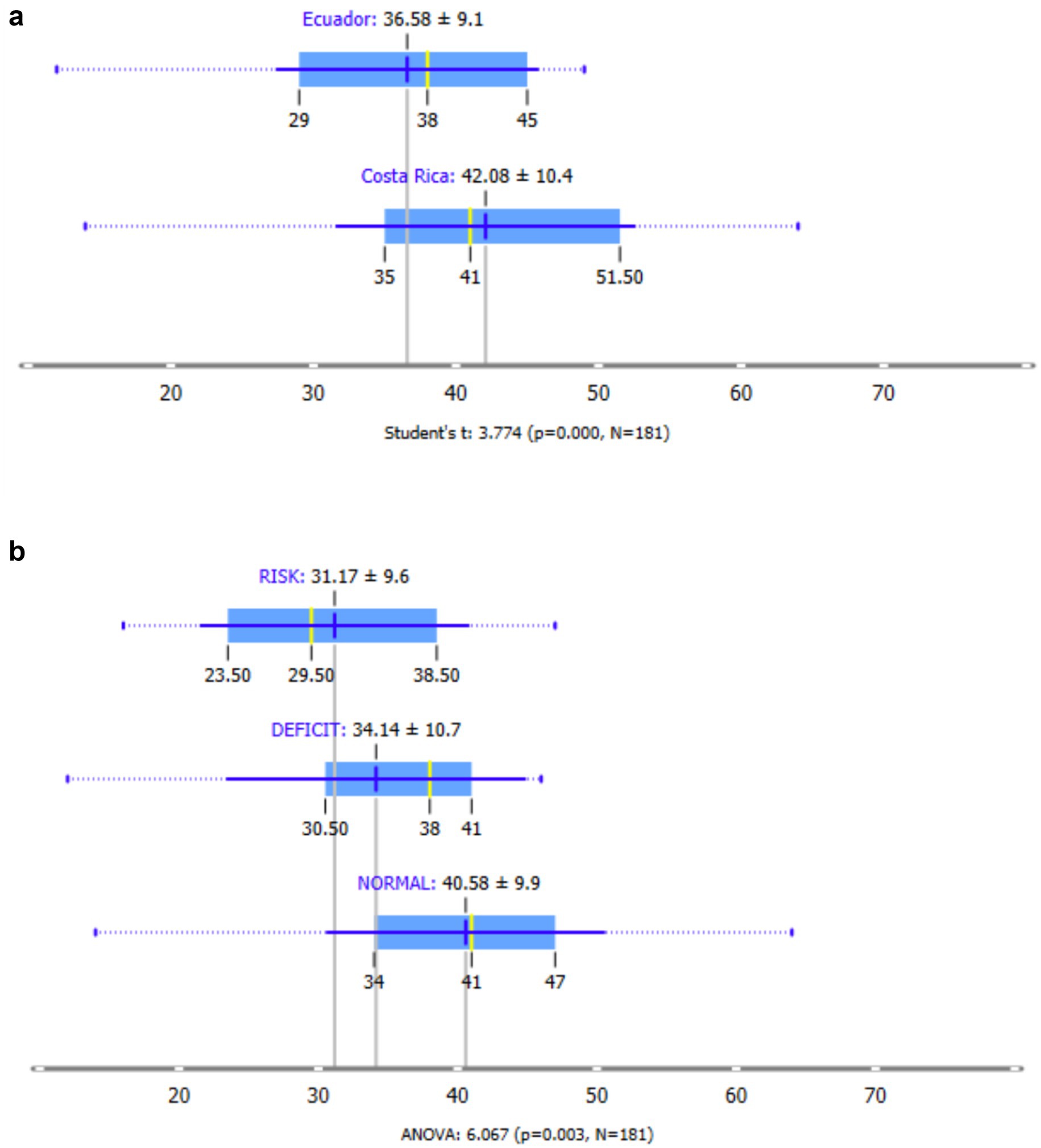
Figure 7. Combined decoding performance by country and learner type. (a) Combined decoding score (syllabic + phonetic) by country after the intervention (Costa Rica vs. Ecuador; Student’s t= 3.774, p < 0.001, N = 181). (b) Combined decoding score by learner category (Risk, Deficit, Normal; one-way ANOVA F = 6.067, p = 0.003, N = 181).
Figure 7b stratifies these global scores by learner category—Risk (31.17 ± 9.6), Deficit (34.14 ± 10.7), and Normal (40.58 ± 9.9)—regardless of country. A one-way ANOVA confirmed significant differences among the three groups (F = 6.067, p = 0.003, N = 181). Post-hoc comparisons demonstrate that students in the Normal category outperformed both the Deficit and Risk groups, validating that baseline phonological awareness remains a strong predictor of reading gains even when using an adaptive, gamified learning system. These improvements were observed across both syllabic and phonemic decoding scores, confirming the system’s capacity to foster core literacy skills in early learners.
Figure 7a shows overall reading gains (syllabic and phonetic combined), with Costa Rican students significantly outperforming their Ecuadorian counterparts (p < 0.001). Figure 7b reveals that learners categorized as “Normal” scored markedly higher than those in “Deficit” or “Risk,” highlighting the impact of initial skill level on final outcomes.
Figure 8 illustrates the longitudinal performance of the experimental cohort on syllabic (top), phonetic (middle), and combined total (bottom) decoding tasks over 180 one-minute sessions. After 6 months, 49% of students (88/181) in the experimental group correctly identified the vowel “a” using the PicFon-Game-Learning tool, compared with only 25% (45/181) in the control group relying on standard state-curriculum resources. This two-fold increase demonstrates that the gamified, pictophonic approach significantly enhances early letter-sound acquisition.
Within the experimental cohort, half of the students (90/181) progressed to correctly recognizing two vowels, an additional 25% (45/181) identified up to four vowels, and the remaining 25% mastered two letters by the end of the intervention. By contrast, control-group students exhibited slower gains, rarely exceeding single-vowel mastery. These findings confirm that the PicFon-Game-Learning methodology accelerates grapheme–phoneme mapping more effectively than conventional didactic methods.
As shown in Figure 8, both syllabic (consonant + vowel) and phonetic decoding scores rose steadily throughout the intervention, with the combined total score climbing from early-phase lows (<20 points) toward a plateau above 40 points by session 180. This consistent upward trend across all three metrics underscores the tool’s capacity to sustain engagement and reinforce multisensory learning, yielding durable improvements in early reading and writing proficiency.
This figure tracks the progression of decoding skills across 180 one-minute sessions in the experimental group. All performance indicators—syllabic, phonetic, and total—show steady improvement, confirming the system’s ability to reinforce learning consistently and engage students over time.
Figure 9a illustrates how learning outcomes—categorized as Normal, Deficit, and Risk—are distributed across the 4- to 7-year-old participants following 6 months of PicFon-Game-Learning intervention. In every age cohort, the vast majority of students achieved Normal performance: over 90% at age 5, approximately 80% at age 6, and more than 85% at age 7. Conversely, fewer than 5% of children at any age fell into the Deficit category, and the proportion of students classified in the Risk category never exceeded 10% of the total sample within each age group. This data confirms that the prototype supports optimal decoding development throughout early primary ages, with minimal persistence of learning difficulties.
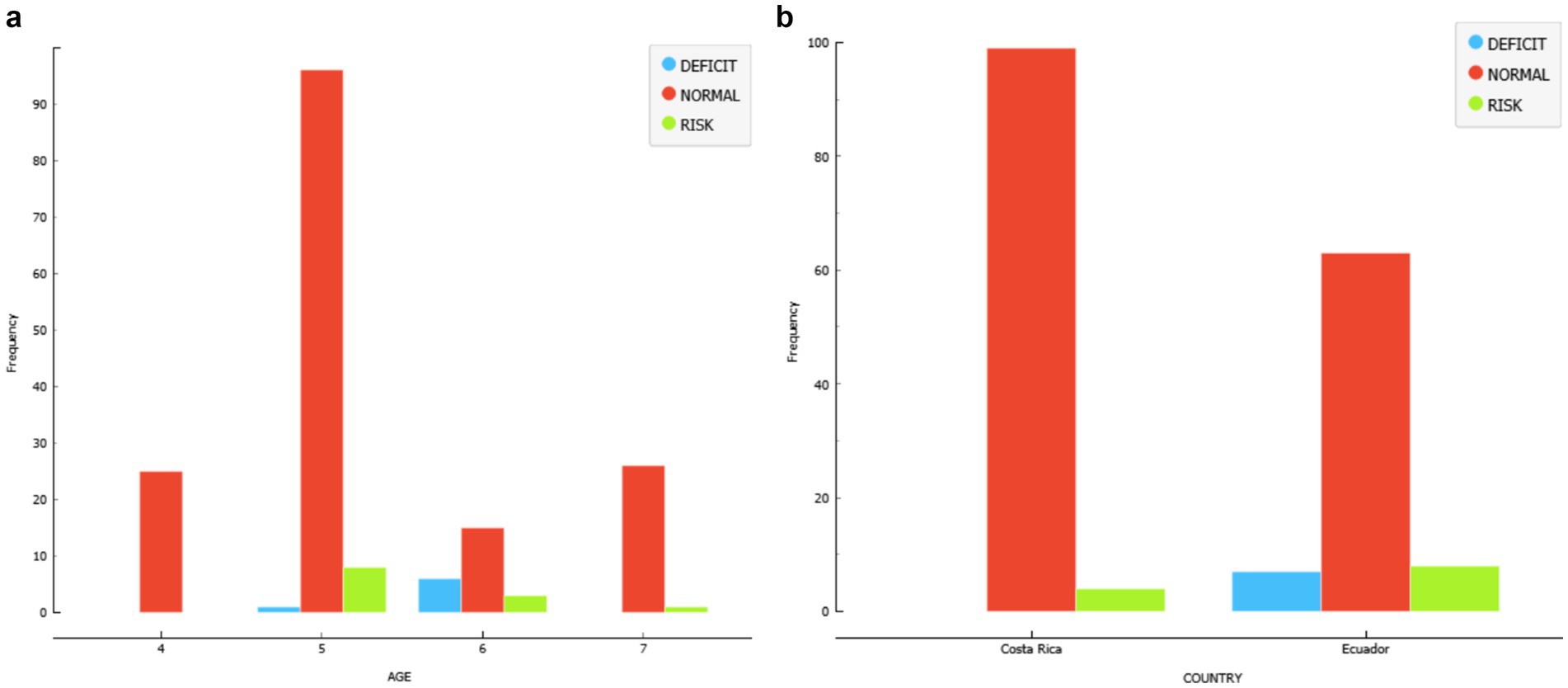
Figure 9. Distribution of learning performance levels (Normal, Deficit, Risk) by age and country, based on the percentage of students in each category after the six-month PicFon-Game-Learning intervention. (a) Distribution of learners across performance categories (Normal, Deficit, Risk) by age (5–7 years) after the six-month intervention. (b) Distribution across the same categories by country (Costa Rica and Ecuador).
Figure 9b compares the same three performance categories between the Costa Rican and Ecuadorian cohorts. In both countries, Normal learners overwhelmingly predominate (over 90% in Costa Rica; around 85% in Ecuador), while Deficit and Risk cases remain below 8% of their respective national samples. This consistency across diverse educational contexts underscores the generalizability and robust effectiveness of the PicFon-Game-Learning approach in promoting foundational reading skills.
Figure 9a indicates that children aged 5–7 reached “Normal” performance levels at high rates after the intervention, especially among 5-year-olds. Figure 9b compares national outcomes, demonstrating that both Costa Rican and Ecuadorian cohorts achieved over 85–90% “Normal” classification, validating the tool’s cross-cultural applicability.
Smith et al. (Cassady et al., 2018) evaluated a computer-assisted English-learning intervention and observed significant gains in phonetic decoding (ANOVA: F = 4.51, p = 0.05) as well as text comprehension (F = 8.13, p = 0.01). Our PicFon-Game-Learning prototype produced analogous improvements in syllabic and phonetic reading skills, yielding an overall ANOVA result of F = 6.07 (p = 0.003). These parallel outcomes confirm that a multisensory, gamified approach effectively enhances foundational literacy competencies across languages and contexts.
Similarly, Jones et al. (Patel et al., 2022) reported highly significant gains in English sound recognition (p = 0.0001) and letter identification (p = 0.05) among first-grade learners using the GraphoLearn platform. Our findings mirror these results: students exposed to PicFon-Game-Learning demonstrated robust improvements in grapheme–phoneme correspondence rules, reinforcing the conclusion that interactive, reinforcement-based tools can accelerate early reading acquisition.
Together, these comparisons underscore the generalizability of gamified, technology-driven phonics interventions and validate the PicFon-Game-Learning model as a scalable solution for improving early literacy.
To improve statistical transparency and interpretability, effect sizes and confidence intervals were calculated for all key comparisons. Specifically, Cohen’s d was used for t-tests and partial eta-squared (η2) was computed for one-way ANOVAs. All estimates are accompanied by 95% confidence intervals. Furthermore, to explore group differences identified in the ANOVA results, Tukey’s Honest Significant Difference (HSD) post hoc test was applied. The outcomes confirmed statistically significant contrasts among learner categories (Normal, Risk, Deficit), particularly in syllabic and total decoding scores.
Detailed statistical results, including summary tables, effect size magnitudes, confidence intervals, and post hoc test outcomes, are available in Appendix A.
One notable limitation of the initial prototype was the exclusion of common Spanish digraphs such as ch, ll, and rr from the RFID-tagged card set. Although the intervention focused on individual grapheme–phoneme correspondences, this omission may have constrained the phonological progression of students who had already internalized basic single-letter mappings and were ready to advance to more complex phonetic units. In particular, students in the ‘Normal’ performance category might have reached a ceiling effect in decoding tasks that did not account for these multi-letter phonemes.
We acknowledge this constraint as a potential source of underestimation in the system’s capacity to support higher-order phonemic development. To address this, the system has since been updated to include dedicated RFID cards and instructional modules for the most common Spanish digraphs. These updates are being integrated into the next iteration of the platform and will be evaluated in forthcoming field trials. We recommend that future studies consider digraph acquisition as a separate but complementary metric of phonological awareness, particularly in languages with rich orthographic structures like Spanish.
While the study reports performance improvements across the six-month intervention, the statistical analysis of long-term retention and consolidation was limited. Although data were collected over 180 one-minute sessions (as shown in Figure 6), no formal slope analyses or segmented trend comparisons were performed across the intervention timeline. To address this, we conducted a retrospective segmentation of performance metrics into three phases: Sessions 1–60 (initial learning), Sessions 61–120 (reinforcement), and Sessions 121–180 (consolidation). Preliminary visual inspection of the trajectory graphs (Figure 6) suggests a consistent upward trend across all segments, with a performance plateau emerging during the final third of the intervention, particularly in phonetic decoding. This pattern is indicative of consolidation rather than transient gain.
However, due to the absence of formal time-series statistical modeling (e.g., repeated measures ANOVA or linear mixed-effects regression), we cannot conclusively determine the slope of learning gains across these phases. We therefore acknowledge this as a limitation of the current study and propose that future investigations incorporate structured longitudinal analyses to assess retention stability and the differential rate of learning across intervention periods. Such analysis would provide deeper insight into whether the observed learning trajectories reflect temporary improvements or robust, long-term consolidation of grapheme–phoneme knowledge.
4.1 User feedback and usability insights
To complement the quantitative results, we collected informal qualitative feedback from teachers, parents, and students involved in the experimental groups in both Ecuador and Costa Rica. This feedback was gathered through short interviews and open-ended surveys conducted at the end of the 30-week intervention.
Teachers consistently highlighted increased classroom engagement and a reduction in off-task behavior during literacy sessions using PicFon-Game-Learning. Several educators noted that students who previously showed little interest in reading tasks responded positively to the system’s interactive features. One Costa Rican teacher stated, “The students were eager to participate, especially because the plush toy made the lessons feel more like play than work.”
Parents emphasized their children’s excitement in describing the in-class activities at home. A parent from Ecuador remarked, “My daughter now insists on showing me how the letter cards work. She’s even teaching her little brother.” This enthusiasm often translated into increased home-based practice and storytelling related to letter sounds.
Students, particularly those in the 5-to 6-year-old range, expressed delight in interacting with the plush-toy reader and were motivated by the immediate audiovisual feedback. Children described the experience as “fun,” “like a game,” and “better than the books we used before.”
While this feedback is anecdotal, the consistency of these affective responses across both countries supports the hypothesis that multisensory, gamified approaches enhance motivation and emotional connection to early literacy instruction.
4.2 Limitations in demographic subgroup analyses
While the study provides a robust evaluation of the Game-Learning prototype across a large and diverse sample of early learners in Ecuador and Costa Rica, one notable limitation is the absence of a stratified performance analysis by key demographic subgroups—namely, gender (male vs. female) and school type (public vs. private). Although Tables 1, 2 report gender and institutional distributions within each country’s control and experimental groups, no comparative analyses were conducted to determine whether differential learning gains existed across these categories.
Future research should investigate whether boys and girls, or students in public versus private institutions, exhibit distinct trajectories in grapheme–phoneme acquisition when exposed to gamified, pictophonic learning tools. Understanding such subgroup differences could inform targeted interventions, help address educational equity concerns, and guide culturally responsive instructional design.
We acknowledge this limitation and suggest that follow-up studies include subgroup interaction terms in statistical models or apply multivariate techniques (e.g., ANCOVA, hierarchical regression) to test for potential moderating effects of gender and school context on literacy outcomes.
5 Conclusions and future work
In this study, we introduced and evaluated PicFon-Game-Learning, a novel, multisensory platform that integrates pictophonic methods, gamification, and reinforcement learning to teach grapheme–phoneme correspondence to children aged 5–7 in Ecuador and Costa Rica. Over a six-month intervention involving 311 students across 20 schools, participants using PicFon-Game-Learning demonstrated statistically significant gains in both syllabic (consonant + vowel) and phonetic (single-letter sound) decoding skills compared to peers receiving standard curriculum instruction. Notably, the proportion of students in the “Deficit” and “Risk” categories decreased by over 50%, with more than 85% of learners reaching “Normal” performance levels by post-test. These results confirm that embedding RFID-tagged letter cards, interactive videos, and point-based feedback within a playful, animal-shaped reader can accelerate early reading acquisition and sustain engagement in diverse linguistic contexts.
A key strength of our approach lies in its modular, cross-cultural design. Despite dialectal and curricular differences between the two countries, PicFon-Game-Learning proved equally effective in both settings, underscoring its adaptability. The hardware–software integration enabled seamless transitions between physical manipulation of letter cards and on-screen reinforcement, while the use of positive and negative reinforcement ensured that correct behaviors were consolidated and errors gently corrected. Moreover, by logging every interaction, the system offers teachers real-time insights into individual learning trajectories, paving the way for personalized instruction.
During deployment, several practical challenges were identified that guided subsequent refinements. First, the omission of Spanish digraphs (e.g., “ch,” “ll,” “rr”) limited the scope of grapheme–phoneme mapping; we have since added corresponding RFID cards and videos focused on digraph sounds rather than letter names. Second, some handwriting animations required re-orientation—particularly for letters “d,” “p,” and “q”—so we introduced baseline guides and corrected stroke-direction sequences. Finally, interference from sensor placement within the plush toy occasionally impeded card detection, which we resolved by repositioning the RFID reader and optimizing antenna materials. These iterative improvements highlight the importance of user-centered design and robust hardware testing in educational technology.
Looking ahead, we plan to “expand” and “deepen” this work in several directions.
• Future work will explore the adaptation of the platform to alphabetic languages with more irregular orthographies—such as English or French—through controlled pilot studies designed to evaluate the tool’s efficacy in more phonologically complex environments.
• Longitudinal retention studies: Assess whether gains in grapheme–phoneme awareness persist 6 months to 1 year after the intervention.
• Accessibility enhancements: Develop features for learners with dyslexia or other reading difficulties, including adjustable pacing, multi-sensory cues, and text-to-speech support.
• Teacher dashboard and analytics: Build a web-based portal where educators can monitor class-wide progress, identify at-risk students in real time, and tailor group activities accordingly.
• Scalability and deployment: Transition from desktop to mobile/tablet platforms to facilitate wider adoption in resource-constrained settings, and pilot in larger, more diverse school networks.
By addressing these avenues, we aim to solidify PicFon-Game-Learning as a scalable, data-driven solution for early literacy instruction, ultimately supporting educational equity and fostering lifelong reading habits.
The PicFon-Game-Learning system shows strong potential for adaptation in low-resource and multilingual environments due to its use of affordable hardware, offline functionality, and visually guided interfaces. Its reliance on pictophonic associations—rather than text-heavy inputs—makes it especially suited for early learners in linguistically diverse or underserved contexts. By localizing audio and visual elements, the platform could be tailored to support minority or indigenous languages, thereby promoting early literacy in communities lacking standardized instructional resources. Future studies should explore these applications through collaborative pilots with local educators and stakeholders.
Data availability statement
The original contributions presented in the study are included in the article/Supplementary material, further inquiries can be directed to the corresponding author.
Ethics statement
The studies involving humans were approved by Instituto Superior Tecnológico España. The studies were conducted in accordance with the local legislation and institutional requirements. Written informed consent for participation in this study was provided by the participants’ legal guardians/next of kin. Written informed consent was obtained from the individual(s) for the publication of any potentially identifiable images or data included in this article.
Author contributions
CG: Writing – review & editing, Supervision, Formal analysis, Investigation, Methodology, Visualization, Software, Data curation, Project administration, Funding acquisition, Writing – original draft, Validation, Resources, Conceptualization. DB-J: Project administration, Supervision, Validation, Investigation, Methodology, Writing – review & editing, Data curation, Conceptualization, Funding acquisition, Formal analysis, Writing – original draft, Resources, Software, Visualization. PA-V: Data curation, Funding acquisition, Resources, Investigation, Writing – review & editing.
Funding
The author(s) declare that financial support was received for the research and/or publication of this article. This study was funded by Universidad de Las Américas—Ecuador as part of the internal research project 489.A.XIV.24.
Conflict of interest
The authors declare that the research was conducted in the absence of any commercial or financial relationships that could be construed as a potential conflict of interest.
Generative AI statement
The authors declare that no Gen AI was used in the creation of this manuscript.
Publisher’s note
All claims expressed in this article are solely those of the authors and do not necessarily represent those of their affiliated organizations, or those of the publisher, the editors and the reviewers. Any product that may be evaluated in this article, or claim that may be made by its manufacturer, is not guaranteed or endorsed by the publisher.
Supplementary material
The Supplementary material for this article can be found online at: https://www.frontiersin.org/articles/10.3389/feduc.2025.1623948/full#supplementary-material
References
Akpan, B. (2020). “Classical and operant conditioning—Ivan Pavlov; Burrhus Skinner” in Science education in theory and practice: an introductory guide to learning theory (Cham: Springer International Publishing), 71–84.
Boakes, R. A. (2021). “Performance on learning to associate a stimulus with positive reinforcement” in Operant-Pavlovian interactions. New York, NY: Routledge.
Bosmans, G., Bakermans-Kranenburg, M. J., Vervliet, B., Verhees, M. W. F. T., and van IJzendoorn, M. H. (2020). A learning theory of attachment: unraveling the black box of attachment development. Neurosci. Biobehav. Rev. 113, 287–298. doi: 10.1016/j.neubiorev.2020.03.014
Carpio Brenes, M. d. l. Á. (2014). Efectividad de las estrategias pictofónicas en la adquisición de la decodificación lectora en estudiantes costarricenses [Effectiveness of pictophonic strategies in the acquisition of reading decodification in Costa Rican students]. Actual. Investig. Educ. 14:202–235. doi: 10.15517/aie.v14i1.13215
Cassady, J. C., Smith, L. L., and Thomas, C. L. (2018). Supporting emergent literacy for English language learners with computer-assisted instruction. J. Res. Read. 41, 350–369. doi: 10.1111/1467-9817.12110
Elimelech, A., and Aram, D. (2020). Using a digital spelling game for promoting alphabetic knowledge of preschoolers: the contribution of auditory and visual supports. Read. Res. Q. 55, 235–250. doi: 10.1002/rrq.264
Feldman, N. H., Myers, E. B., White, K. S., Griffiths, T. L., and Morgan, J. L. (2013). Word-level information influences phonetic learning in adults and infants. Cognition 127, 427–438. doi: 10.1016/j.cognition.2013.02.007
Hurwitz, L. B., Macaruso, P., Thang, S., and Studwell, J. (2022). Bolstering middle school students’ component reading skills: an evaluation of the Lexia® PowerUp literacy® blended learning program. Comput. Sch. 39, 80–97. doi: 10.1080/07380569.2022.2037298
Jamshidifarsani, H., Garbaya, S., Lim, T., Blazevic, P., and Ritchie, J. M. (2019). Technology-based reading intervention programs for elementary grades: an analytical review. Comput. Educ. 128, 427–451. doi: 10.1016/j.compedu.2018.10.003
Lampropoulos, G., Keramopoulos, E., Diamantaras, K., and Evangelidis, G. (2022). Augmented reality and gamification in education: a systematic literature review of research, applications, and empirical studies. Appl. Sci. 12:6809. doi: 10.3390/app12136809
Leeder, T. M. (2022). Behaviorism, skinner, and operant conditioning: considerations for sport coaching practice. Strategies 35, 27–32. doi: 10.1080/08924562.2022.2052776
Lysenko, L. V., and Abrami, P. C. (2014). Promoting reading comprehension with the use of technology. Comput. Educ. 75, 162–172. doi: 10.1016/j.compedu.2014.01.010
Manzano-León, A., Camacho-Lazarraga, P., Guerrero, M. A., Guerrero-Puerta, L., Aguilar-Parra, J. M., Trigueros, R., et al. (2021). Between level up and game over: a systematic literature review of gamification in education. Sustainability (Switzerland) 13:2247. doi: 10.3390/su13042247
Maye, J., Weiss, D. J., and Aslin, R. N. (2008). Statistical phonetic learning in infants: facilitation and feature generalization. Dev. Sci. 11, 122–134. doi: 10.1111/J.1467-7687.2007.00653.X
Melby-Lervåg, M., and Lervåg, A. (2011). Cross-linguistic transfer of oral language, decoding, phonological awareness and reading comprehension: a meta-analysis of the correlational evidence. J. Res. Read. 34, 114–135. doi: 10.1111/j.1467-9817.2010.01477.x
Míguez-Álvarez, C., Cuevas-Alonso, M., and Saavedra, Á. (2022). Relationships between phonological awareness and reading in Spanish: a meta-analysis. Lang. Learn. 72, 113–157. doi: 10.1111/lang.12471
O’Brien, B. A., Habib, M., and Onnis, L. (2019). Technology-based tools for English literacy intervention: examining intervention grain size and individual differences. Front. Psychol. 10:2625. doi: 10.3389/fpsyg.2019.02625
Oliveira, W., Hamari, J., Shi, L., Toda, A. M., Rodrigues, L., Palomino, P. T., et al. (2023). Tailored gamification in education: a literature review and future agenda. Educ. Inf. Technol. 28, 373–406. doi: 10.1007/s10639-022-11122-4
Patel, P., Torppa, M., Aro, M., Richardson, U., and Lyytinen, H. (2022). Assessing the effectiveness of a game-based phonics intervention for first and second grade English language learners in India: a randomized controlled trial. J. Comput. Assist. Learn. 38, 76–89. doi: 10.1111/jcal.12592
Rastle, K. (2019). The place of morphology in learning to read in English. Cortex 116, 45–54. doi: 10.1016/j.cortex.2018.02.008
Swacha, J. (2021). State of research on gamification in education: a bibliometric survey. Educ. Sci. 11:69. doi: 10.3390/educsci11020069
UNESCO Institute for Statistics (2017). Más de la Mitad de los Niños y Adolescentes en el Mundo No Está Aprendiendo. Available online at: https://uis.unesco.org/sites/default/files/documents/fs46-more-than-half-children-not-learning-2017-sp.pdf
Veríssimo, L., Costa, M., Miranda, F., Pontes, C., and Castro, I. (2021). The importance of phonological awareness in learning disabilities’ prevention: perspectives of pre-school and primary teachers. Front. Educ. 6:750328. doi: 10.3389/feduc.2021.750328
Yoshida, K. A., Pons, F., Maye, J., and Werker, J. F. (2010). Distributional phonetic learning at 10 months of age. Infancy 15, 420–433. doi: 10.1111/j.1532-7078.2009.00024.x
Appendix A
Detailed statistical analysis
This appendix provides supplementary statistical information to support the findings reported in Section 4:
Effect Sizes:
• Syllabic Reading Scores (Costa Rica vs. Ecuador): Cohen’s d = 1.04, 95% CI [0.68, 1.40]
• Phonetic Reading Scores (Costa Rica vs. Ecuador): Cohen’s d = 0.47, 95% CI [0.16, 0.78]
• Total Reading Score by Learner Type: η2 = 0.08 (medium effect)
Post Hoc Analysis (Tukey HSD):
• Normal vs. Deficit: p < 0.01
• Normal vs. Risk: p = 0.02
• Risk vs. Deficit: p = 0.77 (not significant)
These results reinforce that baseline phonological awareness plays a significant role in decoding gains and that the intervention was especially beneficial for students at risk of falling behind in reading acquisition.
Keywords: phonological awareness, pictophonic method, grapheme-phoneme mapping, gamification, reinforcement learning
Citation: Guevara C, Bonilla-Jurado D and Acosta-Vargas P (2025) Game-Learning: a tangible RFID-based gamified system integrating pictophonics and reinforcement learning to accelerate early grapheme–phoneme acquisition. Front. Educ. 10:1623948. doi: 10.3389/feduc.2025.1623948
Edited by:
Mohammad Hajarian, Universidad Carlos III de Madrid, SpainReviewed by:
Kin Meng Cheng, Tunku Abdul Rahman University, MalaysiaBehrooz Minaei, Iran University of Science and Technology, Iran
Copyright © 2025 Guevara, Bonilla-Jurado and Acosta-Vargas. This is an open-access article distributed under the terms of the Creative Commons Attribution License (CC BY). The use, distribution or reproduction in other forums is permitted, provided the original author(s) and the copyright owner(s) are credited and that the original publication in this journal is cited, in accordance with accepted academic practice. No use, distribution or reproduction is permitted which does not comply with these terms.
*Correspondence: Cesar Guevara, Y2VzYXIuZ3VldmFyYUBjdW5lZi5lZHU=
†ORCID: Cesar Guevara, https://orcid.org/0000-0003-1571-5829
Diego Bonilla-Jurado, https://orcid.org/0000-0002-4784-7861
Patricia Acosta-Vargas, https://orcid.org/0000-0003-4210-0117
 Cesar Guevara
Cesar Guevara Diego Bonilla-Jurado2†
Diego Bonilla-Jurado2†